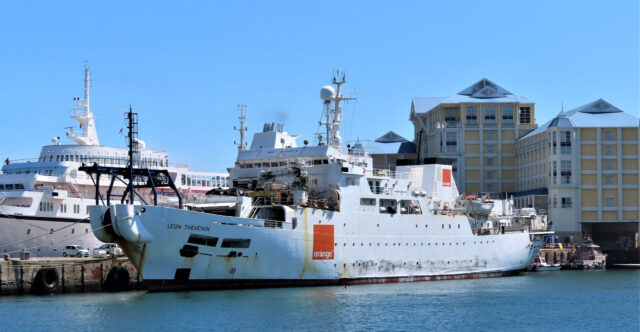Internet cable repair ship sets sail | Orange’s Marine’s Léon Thévenin ship has departed South Africa and is on its way to the area where four undersea cables broke last week, causing widespread Internet outages and slowdowns in South Africa and several other African countries.
The ship was loaded up with fibre optic cable in Cape Town harbour before setting off to the coastal waters of Abidjan, Cote d’Ivoire on Tuesday evening.
According to vessel tracking website MarineTraffic, the Thévenin departed at around 20:47 on Tuesday, 19 March 2024. Its estimated arrival in Abidjan is 06:00 on Friday, 29 March 2024.
The Thévenin can handle repairs in waters as shallow as 10 metres and as deep as 7km.
It is equipped with general cable works tools — including grapnels, buoys, ropes, and dead-weights — as well as a remotely operated vehicle for detecting, cutting, recovering, jointing and testing undersea fibre cables.
A second ship expected to attend to the cable breaks — Global Marine’s CS Sovereign — was still moored in Portland, England, at 08:15 on Wednesday, 20 March 2024.
The screenshots below from MarineTraffic show the ship’s rough location and forecasted route to the site of the cable breaks.
Four submarine telecommunications cables connecting African countries to Europe and other parts of the world went offline at about 12:30 on Thursday, 14 March 2024 — the West Africa Cable System (WACS), Africa Coast to Europe (ACE), MainOne, and SAT–3 cables.
Earlier breaks on the Seacom, EIG, and AAE–1 cables suspected to have been caused by Houthi terrorists sinking a fertiliser ship in the Red Sea in late February have also led to lowered capacity on the east coast of Africa.
While the cause of the breaks remains to be confirmed, a preliminary analysis by submarine fibre cable operator MainOne indicates that seismic activity on the seabed caused its submarine fibre cable to break.
MainOne said the distance from land and the cable depth of about 3km at the point of the fault ruled out any kind of human activity, including damage from ship anchors, fishing, drilling, or sabotage.
“We will obtain more data when the cable is retrieved during the repair exercise,” the company said.
Although the U.S. Geological Survey did not detect any earthquakes in the vicinity of the cable breaks last week, it does not rule out other possible activity on the seabed.
Repairs will take several weeks
MainOne estimated repairing the cables would take three to five weeks. This correlated with estimates from Ghana’s communications regulator and Telkom.
The former told Reuters that fixing the damaged cables would take at least five weeks, based on feedback from meetings with four subsea cables’ landing service providers and mobile network operators.
Telkom, who is part of the WACS consortium, has told Bloomberg that it expects the repairs to take about three weeks, depending on weather conditions.
That would put the estimated time of restoration around early or mid-April 2024.
However, it was unclear whether this was limited to fixes on certain or all cables and if it included the time from when the ship set off or only applied from the time of arrival at the site of the breaks.
The Thévenin previously took roughly four weeks to repair breaks on WACS, ACE, and SAT-3 last year, including travel time from Cape Town harbour.
In that case, the site of the breaks was roughly 3,600km from the harbour, closer than the 4,900km distance between Cape Town and Abidjan. Internet cable repair ship sets sail




























